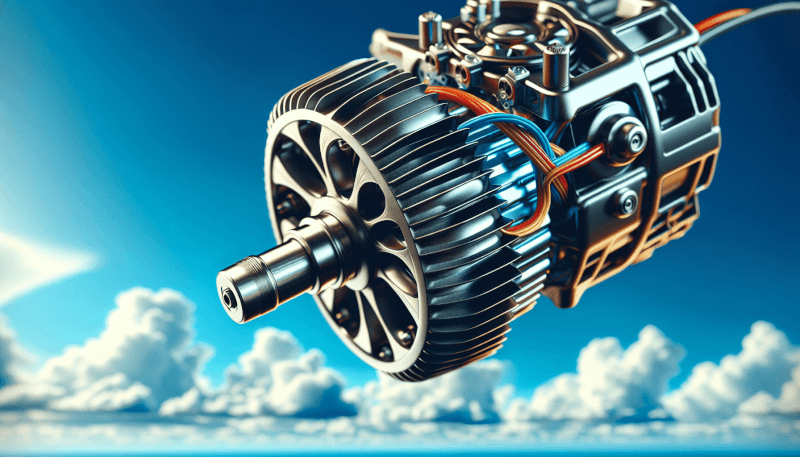Are you an RC helicopter enthusiast looking to upgrade your motor? Choosing the right motor for your needs is crucial to ensure optimal performance and enjoyment of your hobby. In this article, we will guide you through the process of selecting the best RC helicopter motor, taking into consideration factors like power, size, and compatibility with your helicopter model. Whether you’re a beginner or a seasoned pro, our tips and recommendations will help you make an informed decision and take your RC helicopter experience to new heights.

Understanding RC Helicopter Motors
RC helicopters are an exciting and popular hobby for many people, providing hours of fun and entertainment. One of the key components of an RC helicopter is its motor, which is responsible for powering the rotor blades and providing the thrust needed for flight. Understanding the different types of RC helicopter motors and how to choose the right one for your needs is crucial for ensuring optimal performance and enjoyment.
Types of RC Helicopter Motors
There are several different types of motors used in RC helicopters, each with its own set of advantages and considerations. The three main types of RC helicopter motors are brushed motors, brushless motors, and coreless motors. Let’s take a closer look at each type.
Brushed Motors
Brushed motors are the most common type of motor found in entry-level RC helicopters. They are relatively inexpensive and easy to maintain, making them a popular choice for beginners. These motors work by sending an electric current through a series of brushes and a commutator, which creates a magnetic field that drives the rotor blades.
While brushed motors are affordable and easy to replace, they do have some downsides. They are less efficient than brushless motors and tend to wear out more quickly. Additionally, brushed motors may produce more heat and noise compared to other types. Despite these drawbacks, brushed motors are a good option for those on a budget or just starting out in the hobby.
Brushless Motors
Brushless motors are a more advanced and efficient option for RC helicopters. Instead of using brushes and a commutator, brushless motors use electronic speed controllers (ESCs) to power the motor. This design eliminates the need for brushes, resulting in smoother operation and increased efficiency.
Brushless motors offer several advantages over brushed motors. They deliver more power and higher RPMs, allowing for greater speed and performance. Additionally, brushless motors tend to have a longer lifespan due to the absence of brushes that can wear out. However, brushless motors are generally more expensive than their brushed counterparts, which is an important consideration when choosing a motor.
Coreless Motors
Coreless motors are another type of motor commonly used in micro RC helicopters. These motors are characterized by their compact size and lightweight design. Unlike brushed and brushless motors, coreless motors do not have an iron core in the rotor. Instead, they use a coil that is wound directly onto the rotor, resulting in reduced weight and increased efficiency.
Coreless motors offer several advantages, such as improved power output and responsiveness. They are also known for their smooth operation and low noise levels. Coreless motors are an excellent choice for micro RC helicopters due to their compact size and weight savings. However, they may not provide enough power for larger or more demanding helicopters.
Determining Motor Size and Power
When choosing an RC helicopter motor, it is important to consider the size and power requirements of your helicopter. The size of the motor will directly affect the performance and flight characteristics of your helicopter, so selecting the right size is crucial.
The size of an RC helicopter motor is typically measured in millimeters (mm) and refers to the diameter of the motor. Common motor sizes range from 22mm to 50mm, with larger motors generally providing more power. It is important to choose a motor size that is compatible with your helicopter’s frame and weight.
Power output is another important consideration when selecting an RC helicopter motor. The power of a motor is typically measured in watts (W) or kilowatts (kW). A higher power output will result in increased thrust and performance, but it is important to ensure that your helicopter is capable of handling the extra power.
Understanding Motor KV Rating
The KV rating of a motor is another important factor to consider when choosing an RC helicopter motor. The KV rating refers to the number of revolutions per minute (RPM) that the motor will rotate when a given voltage is applied, with a higher KV rating indicating a faster RPM.
Choosing the right KV rating for your needs depends on several factors, including the size and weight of your helicopter, as well as your intended use. Higher KV motors are generally better suited for smaller, lighter helicopters that require more RPM to generate sufficient lift. On the other hand, lower KV motors are typically used in larger helicopters that require more torque and power.
Choosing the Right Motor Size
Selecting the right motor size for your RC helicopter is crucial for optimal performance. The size of the motor should be compatible with the size and weight of your helicopter, ensuring that it can provide sufficient power for flight.
Smaller RC helicopters, such as micro or mini models, typically require smaller motors in the range of 22mm to 30mm. These motors are lightweight and compact, making them ideal for these smaller helicopters. On the other hand, larger RC helicopters, such as 450mm or 600mm models, require larger motors in the range of 40mm to 50mm to provide enough power for flight.
It is important to consult the manufacturer’s recommendations or seek advice from experienced RC enthusiasts when choosing the right motor size for your helicopter. They can provide valuable insights and recommendations based on their own experiences and knowledge.
Considering Power Output
The power output of an RC helicopter motor is a key consideration when selecting the right motor for your needs. Power output is typically measured in watts (W) or kilowatts (kW) and directly affects the thrust and performance of your helicopter.
For beginners or those flying smaller helicopters, a motor with a lower power output may be sufficient. These motors provide enough power for basic flight maneuvers and are generally more forgiving for beginners. As you progress in skill level or if you have a larger, more demanding helicopter, you may want to consider a motor with higher power output to ensure optimal performance.
It is important to balance the power output of the motor with the capabilities of your helicopter and your own skill level. Choosing a motor with too high of a power output for your helicopter may result in instability or difficulty controlling the aircraft.
Identifying Motor Efficiency
Motor efficiency is an important consideration when choosing an RC helicopter motor. Efficiency can affect the overall performance, flight time, and battery life of your helicopter.
Efficiency refers to how effectively the motor converts electrical energy into mechanical energy. A more efficient motor will require less energy to produce the same amount of power, resulting in longer flight times and improved battery life. Brushless motors are known for their high efficiency, making them a popular choice among RC enthusiasts.
When comparing different motor options, it is helpful to look for specifications or information on the efficiency of the motor. This can help you make an informed decision and select a motor that not only meets your power requirements but also offers optimal efficiency.
Understanding Motor Cooling
Motor cooling is another important aspect to consider when choosing an RC helicopter motor. During operation, motors can generate a significant amount of heat, which can affect performance and potentially damage the motor if not properly managed.
To prevent overheating, many RC helicopter motors are equipped with cooling mechanisms such as heat sinks or cooling fans. These cooling mechanisms help dissipate heat and keep the motor running at optimal temperatures. Additionally, some motors may feature built-in temperature sensors or thermal protection systems to prevent damage from excessive heat.
When selecting an RC helicopter motor, consider the cooling capabilities and features of the motor to ensure proper heat management. This can help prolong the lifespan of the motor and maintain optimal performance during flight.
Factors to Consider When Choosing an RC Helicopter Motor
Choosing the best RC helicopter motor for your needs requires careful consideration of several factors. Here are some important factors to keep in mind when making your decision:
Budget
Your budget is an important consideration when choosing an RC helicopter motor. Motors can vary greatly in price, with brushless motors generally being more expensive than brushed motors. Consider how much you are willing to spend and look for a motor that offers the best combination of performance and value within your budget.
Helicopter Type and Size
The type and size of your helicopter will greatly influence the motor you choose. Smaller, lightweight helicopters typically require smaller motors, while larger, more powerful helicopters require larger motors. Consult the manufacturer’s recommendations or seek advice from experienced RC enthusiasts to ensure compatibility between your helicopter and motor.
Skill Level
Your skill level as a pilot is another important factor to consider when choosing an RC helicopter motor. Beginner pilots may benefit from a motor with less power and a lower KV rating, as these motors are generally easier to control and more forgiving. As you gain more experience and advance in skill level, you may opt for a more powerful motor to facilitate more advanced maneuvers.
Intended Use
Consider your intended use for the RC helicopter when selecting a motor. Do you plan to fly recreationally and perform basic maneuvers, or do you have more ambitious plans for aerobatic or 3D flying? The intended use of your helicopter will dictate the power and performance requirements of the motor.
Flight Time
Flight time is an important consideration, especially if you plan on flying for extended periods. More efficient motors will typically offer longer flight times, as they require less energy to produce the same amount of power. Consider the efficiency of the motor and how it may impact the flight time of your helicopter.
Matching the Motor to the Helicopter
Matching the motor to the helicopter is crucial for optimal performance and flight characteristics. Consider the following factors when matching the motor to your helicopter:
Weight and Power Ratio
The weight and power ratio is an important consideration when matching the motor to your helicopter. A motor that is too weak for the weight of the helicopter may struggle to generate sufficient lift and result in poor performance. On the other hand, a motor that is too powerful for the weight of the helicopter may lead to instability or difficulty controlling the aircraft. Seek recommendations or consult the manufacturer’s guidelines to ensure you select a motor that provides the appropriate power for your helicopter’s weight.
Helicopter Performance
Consider the desired performance of your helicopter when selecting a motor. Do you want a high-speed, agile helicopter, or are you looking for a more stable and easy-to-control aircraft? Different motors will offer different levels of power and torque, which directly affect the performance and flight characteristics of your helicopter. Match the motor to the desired performance to ensure an enjoyable and satisfying flying experience.
Compatibility with ESC
The motor you choose should be compatible with the electronic speed controller (ESC) used in your helicopter. The ESC controls the power delivered to the motor and manages its speed and performance. Ensure that the motor you choose is compatible with the voltage and amperage ratings of your ESC to avoid compatibility issues and potential damage to the components.
Determining the KV Rating
The KV rating of an RC helicopter motor is an important factor to consider when choosing the right motor for your needs. Understanding the KV rating and its implications can help you select a motor that suits your helicopter and flying style.
What is a KV Rating?
The KV rating indicates the number of revolutions per minute (RPM) that the motor will rotate when a given voltage is applied. A higher KV rating indicates a faster RPM, while a lower KV rating indicates a slower RPM. The KV rating of a motor plays a significant role in the performance and characteristics of your helicopter.
Choosing the Right KV Rating for Your Needs
Choosing the right KV rating depends on several factors, such as the size and weight of your helicopter, as well as your flying style. Smaller, lighter helicopters generally benefit from higher KV ratings, as they require more RPM to generate sufficient lift. On the other hand, larger helicopters or those designed for more aggressive flying may require lower KV ratings to deliver the necessary torque and power.
When selecting a motor, consider the manufacturer’s recommendations and seek advice from experienced pilots who have similar helicopter setups. They can provide valuable insights and recommendations based on their own experiences and knowledge.
High KV vs. Low KV Motors
High KV and low KV motors each have their own advantages and considerations. High KV motors are generally better suited for smaller, lighter helicopters, as they provide the necessary speed and responsiveness. They are ideal for fast-paced flying and aerobatic maneuvers. However, high KV motors may generate more heat and require more power, which can result in shorter flight times and increased wear on the motor.
On the other hand, low KV motors are better suited for larger, heavier helicopters that require more torque and power. They are generally more efficient and generate less heat, resulting in longer flight times and improved motor longevity. However, low KV motors may sacrifice some speed and responsiveness compared to high KV motors.
Consider your helicopter’s size, weight, and intended use when choosing between high KV and low KV motors. Strike a balance between power, efficiency, and flight characteristics to find the motor that best meets your needs.

Understanding Motor Specifications
Understanding the key specifications of an RC helicopter motor can help you make an informed decision and select the right motor for your needs.
Voltage Range
The voltage range refers to the acceptable range of voltage that the motor can handle. It is important to choose a motor that is compatible with the voltage rating of your power source, such as the battery or ESC. Using a motor with a voltage outside of its specified range can result in poor performance or damage the motor.
Maximum Amperage
The maximum amperage, or current, rating of a motor indicates the maximum amount of electrical current that the motor can safely handle. It is important to choose a motor with a maximum amperage rating that is compatible with your power system, including the ESC and battery. Using a motor with a maximum amperage rating lower than that of your power system can result in overheating or damage to the motor.
Motor Dimensions
The physical dimensions of the motor, such as the diameter and length, are important considerations when choosing a motor. The motor should fit within the frame of your helicopter and allow for proper installation and alignment. Consider the available space and mounting options in your helicopter when selecting a motor.
Shaft Diameter and Length
The shaft diameter and length of the motor are important considerations, especially when selecting a pinion gear or rotor head assembly. The shaft diameter should match the hole size of the pinion gear or rotor head, ensuring a secure and precise fit. The shaft length should also allow for proper engagement with the gear or rotor head without protruding excessively.
Mounting and Fastening Options
Consider the mounting and fastening options of the motor when selecting a motor for your RC helicopter. Different motors may have different mounting hole patterns or fastening mechanisms. Ensure that the motor is compatible with your helicopter’s frame and supports secure and reliable mounting.
Considerations for Brushed Motors
Brushed motors have their own set of advantages and considerations that should be taken into account when choosing a motor.
Advantages of Brushed Motors
One of the main advantages of brushed motors is their affordability. Brushed motors are generally more budget-friendly compared to brushless motors, which makes them an excellent option for those on a limited budget or just starting out in the hobby.
Brushed motors are also relatively easy to maintain and replace. The brushes can be easily replaced when they wear out, and the motor itself can be cleaned and serviced without much difficulty. This simplicity and accessibility are ideal for beginners who may not have much experience with RC helicopter maintenance.
Disadvantages of Brushed Motors
Despite their affordability and ease of maintenance, brushed motors do have some downsides. One of the main disadvantages is their lower efficiency compared to brushless motors. Brushed motors tend to consume more power and generate more heat, which can lead to shorter flight times and reduced overall performance.
Additionally, brushed motors tend to have a shorter lifespan compared to brushless motors. The brushes in brushed motors are subject to wear and tear, and they will eventually need to be replaced. This additional maintenance and replacement can add to the overall cost and effort required to maintain a brushed motor.
Applications for Brushed Motors
Brushed motors are commonly used in entry-level or beginner RC helicopters. They are an excellent choice for those who are new to the hobby and want a cost-effective option to get started. Additionally, brushed motors are still widely used in indoor or micro RC helicopters due to their smaller size and weight.
Maintenance and Lifespan of Brushed Motors
To ensure the longevity and optimal performance of brushed motors, regular maintenance is necessary. The brushes should be inspected and replaced as needed to prevent performance degradation. Additionally, keeping the motor clean and free from debris will help prolong its lifespan.

Considerations for Brushless Motors
Brushless motors offer several advantages over brushed motors, but they also come with their own considerations.
Advantages of Brushless Motors
One of the main advantages of brushless motors is their increased efficiency. Brushless motors do not have brushes, which eliminates the friction and wear associated with brushed motors. This increased efficiency results in longer flight times, reduced heat generation, and improved overall performance.
Brushless motors also offer higher power output compared to brushed motors. They are capable of delivering more torque and RPM, which translates to faster speeds and improved aerobatic capabilities. This makes brushless motors an excellent choice for those who want more advanced flying experiences and higher performance.
Disadvantages of Brushless Motors
The main disadvantage of brushless motors is their higher cost compared to brushed motors. Brushless motors are generally more expensive, which can be a limiting factor for those on a budget or just starting out in the hobby. The overall investment in brushless motors is higher, as they often require compatible ESCs and other components.
Another consideration is the complexity of brushless motors. They require electronic speed controllers (ESCs) to control the power delivery and ensure smooth operation. This adds an additional layer of complexity compared to brushed motors, which may require more technical knowledge or experience to properly set up and maintain.
Applications for Brushless Motors
Brushless motors are widely used in intermediate and advanced RC helicopters. Their higher power output and efficiency make them a popular choice among experienced pilots who demand superior performance. Brushless motors are also commonly used in larger RC helicopters or those designed for aerobatic or 3D flying.
Maintenance and Lifespan of Brushless Motors
Compared to brushed motors, brushless motors generally require less maintenance and have a longer lifespan. The absence of brushes eliminates the need for regular replacement, and the overall design of brushless motors results in less wear and tear. However, regular inspection and cleaning of brushless motors are still recommended to ensure optimum performance and longevity.
Considerations for Coreless Motors
Coreless motors offer certain advantages and considerations that should be taken into account when choosing this type of motor.
Advantages of Coreless Motors
One of the main advantages of coreless motors is their lightweight and compact design. Coreless motors weigh less and have a smaller size compared to brushed and brushless motors. This makes them ideal for micro or mini RC helicopters, where weight and size are critical factors.
Coreless motors are also known for their smooth operation and low noise levels. They provide excellent responsiveness and deliver power consistently, resulting in a pleasant flying experience. Additionally, coreless motors typically have a longer lifespan compared to brushed motors due to their design.
Disadvantages of Coreless Motors
Despite their advantages, coreless motors may not provide enough power for larger or more demanding helicopters. These motors are best suited for lightweight and smaller helicopters, as they may struggle to generate sufficient thrust for larger models. Before choosing a coreless motor, consider the weight and power requirements of your helicopter to ensure it is a suitable option.
Applications for Coreless Motors
Coreless motors are commonly used in micro RC helicopters due to their compact size and weight savings. They provide enough power for smaller models and deliver excellent responsiveness. Coreless motors are also used in other small-scale applications, such as drones, robotics, and other miniaturized devices that require compact and lightweight motors.
Maintenance and Lifespan of Coreless Motors
Coreless motors generally require minimal maintenance and have a longer lifespan compared to brushed motors. The absence of brushes reduces the possibility of wear and tear, and the overall design of coreless motors promotes efficient and reliable operation. However, regular inspection and cleaning are still recommended to ensure optimal performance and longevity.

Choosing the Best RC Helicopter Motor for Different Skill Levels
The skill level of the pilot is an important factor when choosing the best RC helicopter motor. Different skill levels require different motors to ensure a positive and enjoyable flying experience.
Beginner Skill Level
For beginner pilots, it is generally recommended to start with a brushed motor. Brushed motors are more forgiving and easier to control, allowing beginners to focus on mastering fundamental flying skills. Additionally, brushed motors are more affordable, which is advantageous for those who are just starting out and may have a limited budget.
Intermediate Skill Level
As pilots progress to an intermediate skill level, they may want to upgrade to a brushless motor. Brushless motors provide higher power and performance, which can facilitate more advanced maneuvers and flying styles. The increased efficiency of brushless motors also results in longer flight times, allowing intermediate pilots to enjoy longer flights.
Advanced Skill Level
For advanced pilots, brushless motors are the preferred choice. These motors offer the highest power output and performance capabilities, allowing experienced pilots to push the limits of their helicopters. Brushless motors are essential for advanced aerobatic or 3D maneuvers, where superior power and responsiveness are required.
Beyond the skill level considerations, it is important for pilots of all levels to choose a motor that matches their helicopter’s specifications and meets their performance requirements.
Conclusion
Choosing the best RC helicopter motor requires a thorough understanding of the different motor types, their specifications, and the factors to consider for your specific needs. By considering factors such as budget, helicopter type and size, skill level, intended use, and flight time, you can make an informed decision and select the motor that will provide optimal performance and enjoyment.
Be sure to research and compare different motor options, seeking expert advice when needed. Manufacturers’ recommendations, online forums, and experienced RC helicopter enthusiasts can provide valuable insights and recommendations based on their own experiences.
Once you have chosen a motor, it is important to test and fine-tune the setup as needed. Make any necessary adjustments to ensure proper alignment, balance, and performance. Regularly inspect and maintain your motor to ensure longevity and reliability.
With the right motor and a well-matched setup, you can enjoy countless hours of thrilling and satisfying RC helicopter flying. Happy flying!



